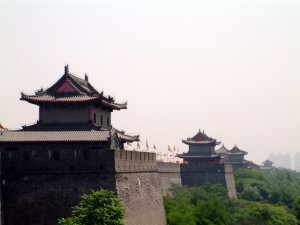In Chinese mountains, business before environment

In its frenzy of development, China could not ignore the mountain. The Liuba station, in the south of the Shaanxi Province, is bound to become one of the jewels of Chinese winter tourism’s policy.
Alas, the development model has already been used in Europe and North America, with ample evidence of its harmfulness. Instead of betting on soft tourism, requiring only small infrastructures with little environmental impact, Chinese policymakers have chosen to replicate the model that has made and continues to do so much damage, especially in the Alps.
The Liuba xian is located at the foot of Mont Zibai (2,610 m), 40 km from Hangzhong and 120 km of X’ian. Between 2007 and 2012, 320 millions Yuan (50 millions Swiss francs) were devoted to tourism development in seven sites. During this period, the xian welcomed over 1.6 millions of tourists, with an average annual growth of 60%. In 2015, the total amount of work had reached 350 millions Yuan (54.5 millions Swiss francs) and two million tourists visited the xian during that single year, against 877,000 in 2011.
The Liuba mechanized ski resort (汉中 紫柏 山滑雪场) opened, for the first time in November 2013. After the first phase of work, amounting to 44 millions Yuan (6.9 millions Swiss francs), it has a ski area of 600 hectares and a snowmobiles park of 81 hectares and two cable-cars have been built.
The second round of investment, amounting to 12 millions Yuan (1.9 millions Swiss francs) began in 2014. A third cable-car is under construction. The goal is to eventually accommodate more than 6,000 people a day in winter.
Furthermore, summer tourism has also led to the construction of additional equipment for allowing all tourists to reach the summit of Mont Zibai. From the top station of the cable car, a stairway was built till the top, to prevent tourists to borrow mountain trails.
Yet the xian has sufficient assets to develop soft and environmentally friendly tourism. It could bet both on its natural and cultural heritage.
The most important landmark is the temple in honour of Zhang Liang. It was first built in the 3rd century. The present buildings date from 1839 and are composed of over 150 halls and rooms.
Another of the culture landmarks is the Shu roads (蜀道). It is a network of mountain roads between Shaanxi and Sichuan, built in the 4th century BC. Most of them were made of wooden planks, laid on wooden or stone beams slotted into holes cut into the sides of cliffs. These paths, in-core feasible at present, may constitute an objective appreciated for hiking enthusiasts
Liuba is also a national ecological demonstration county, with the forest covering nearly 90% of the territory. It hosts more than 410 species of wild animals, twenty-five of which are listed as first- and second-class national protected species, including giant panda, tufted deers, leopards, serows and giant salamanders. More than 1,200 vegetal species are also listed. The Mount Zibai Nature reserve encompasses 200 square kilometres.
Thus, we can only regret that the stakeholders had chosen the easy way of reproducing the worn-out models of alpine development, instead of engaging in innovative projects based on the existing natural and cultural asset already at hands in the area.
(HT)